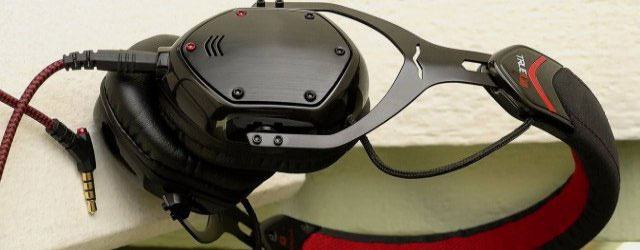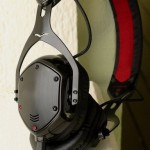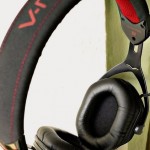V-Moda recently came out with some styling around their existing headsets and then quickly followed this up with a new on-ear headphone called the V-80. Designed as an on-ear more mobile headset and with a special edition True Blood, our man in the field just had to try it out. And so he did.
Technical Specs
40mm Dual-Diaphragm drivers
Vibrant Bass, Vivid Mids, Vivacious Highs
BLISS™ Noise Isolation
V-PORT 3D Soundstage
Lightweight, steel construction
Ergonomic Steelflex Headband
Exoskeleton blood vial case
Military-Level quality (MIL-STD-810G)
Kevlar® reinforced cables pass
1 million flex cycles
The V-80 and M-80 are identical according to V-Moda except for the additional red accents on the V-80 model. For the V-80 that I purchased, I found the sound somewhat recessed in the high-end compared to other headphones I have, so I used the iPod’s ‘Acoustic’ EQ setting for most of my tests and comparisons. The overall sound quality of the V-80 is so good that you can play it without EQ if that proves satisfactory, or try different EQ settings to better match your personal preferences.
Those other headphones I have are considered to be “bright” by some users, so the V-80 may be just as close to ideal with the high-end tones as they are.
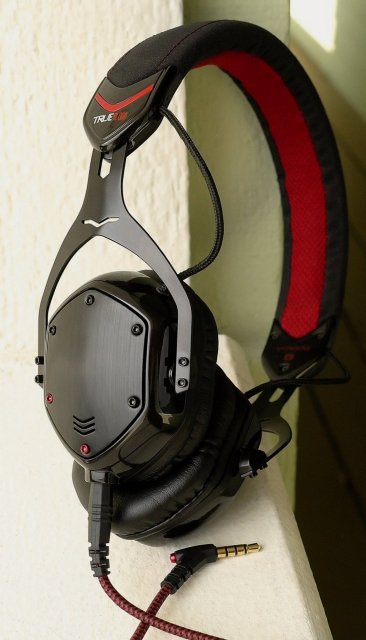
The one headphone I’ve used that to me sounds most similar to the V-80 is the Beyerdynamic DT-1350, but the DT-1350 has a much greater midrange emphasis than the V-80, and so I think the V-80 would be much easier to adapt to a wide variety of musical tastes.
The bass of the V-80 is tight and detailed, but ‘tight’ in this case does not mean light or thin bass – the bass is prominent and full on any track that actually has bass. I’d rate the V-80’s bass as 9 out of 10, and since I haven’t heard a 10 that means the V-80’s bass is as good as I’ve heard.
The midrange is more difficult to judge since nearly every aspect of music is involved with the midrange in one respect or another. I can say that after playing nearly 100 of my favorite tracks in many different genres, the midrange sounds very good – voices sound right, instruments such as guitars, cellos, trumpets, pipe organs – in short everything I’ve played – sounds marvelous.
The high end of the V-80 sounded less prominent to me than the midrange and bass as I noted above, but what’s interesting here is that even after I added treble with the iPod’s ‘Acoustic’ setting, there is still no problem with sibilance or other harshness. I wanted to make sure that this wasn’t the case due to high-frequency roll off, so I checked my lineup of test tones from about 4 khz up to about 13 khz, and those tones were audible in their proper proportions.
I can’t give the V-80 the same kind of rating for midrange and highs as I gave for the bass, since the bass is 100 times easier to rate than the mids and highs. But the V-80 is the best-sounding portable headphone I’ve used so far, and is second in sound quality only to my two large desktop headphones, the Sennheiser HD-800 and Shure SRH-940.
The V-80 will play quite loudly with portable devices such as most cellphones, iPods and so on. The two straight cords (one red/black and one grey) are detachable, the miniplugs are at a 45 degree angle, and the cords are covered in a fabric that doesn’t snag on my clothing, which is a major plus for me. The carry case is compact enough to include in carry-on luggage on most U.S. flights. I wondered before I saw the V-80 in person if it would attract any unusual attention because of its “True Blood” design. The short answer is no. The design is low-key, elegant, stylish, and can be worn by anyone without concern.
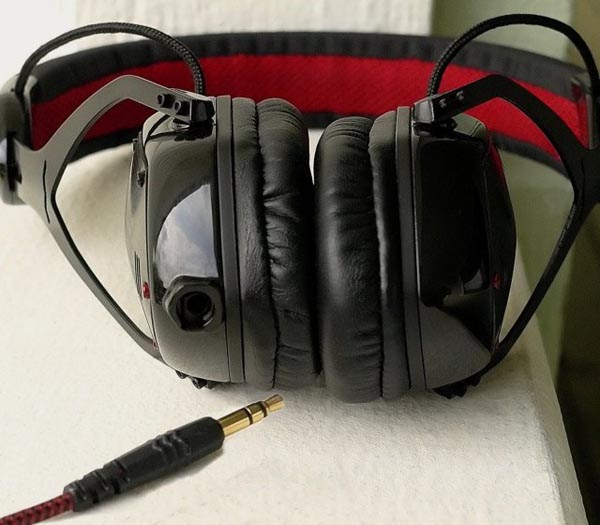
The physical quality of the V-80 is as good as the literature says it is. Comfort is good, with much less pressure on the ears than the Beyer DT-1350 for example. Isolation is very modest though, so don’t expect it to block outside sounds to any major extent. Soundstage is average, which is better than I expected for a small headphone with small ear cups.
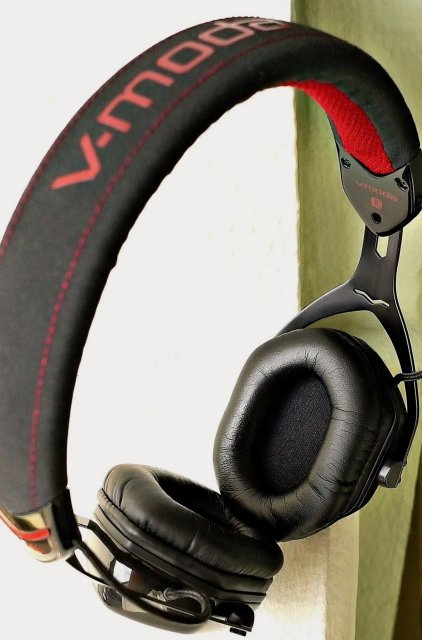
In addition to the pop music tracks listed below, which I used mainly for detecting weaknesses or other problems with the sound, I played a wide variety of genres (Jazz, Diana Krall, Bill Evans Trio; Bach organ, Biggs; Beethoven 9th, Solti CSO; Chopin, Moravec; Reggae, Marley, Tosh; Country, Haggard, Yoakam; Verdi, Domingo; Sinatra and Bennett; Punk, Germs, Fear, Sid Vicious, Social Distortion; Medieval, Madrigali, Medieval Babes; Trance, Mylene Farmer, etc.)
The following are some of the music tracks I tested with, and the main features I listened for with those tracks:
Blues Project – Caress Me Baby (piercing guitar sound, handled very well).
Cocteau Twins – Carolyn’s Fingers (guitar string detail and quality, excellent).
Commodores – Night Shift (bass detail, very good).
Germs – Forming (raw garage sound, excellent).
Lick The Tins – Can’t Help Falling In Love (tin whistle, very clear and clean).
Lou Reed – Walk On The Wild Side (bass impact, very good; detail very good).
REM – Radio Free Europe (drum impact, excellent).
Rolling Stones – She’s So Cold (bass impact, excellent; guitar sound very good).
U2 – With Or Without You (bass boom/high-pitched instruments/sibilance, handled very well).
Van Morrison – Into The Mystic (bass, very good).
Who – Bargain (voice trailing off: “best I ever had”, very good vocal harmonics).
Now that I’ve presented the worst-case scenarios for the V-80/M-80, it’s time to get into the musical qualities in greater detail. As I explained previously, I felt that the highs were too recessed and so I compensated by applying the iPod Touch’s ‘Acoustic’ EQ. This EQ seems to be working out well for me, with the only possible downside that I’m hearing a slight peak in the midrange that gives voices more prominence than what I would like. In some rare cases this can contribute to the “Caruso” effect as I call it, where Caruso recorded into horns that had some remaining resonances after their best design efforts had been exhausted, and so in some passages where he projected his voice most strongly, the otherwise minor resonances amplified those notes out of proportion to the rest of the music. In the V-80’s case it’s not a serious problem, and even then it’s probably a result of my imperfect application of EQ rather than a fault of the headphone.
At this point in my listening, the highs are smooth and extended, and the midrange is under control with reasonably accurate and pleasing reproduction.
Then there’s the bass. Ooooh, the bass. Compared to the Phiaton MS-400, the bass is tighter and more detailed, yet has greater impact. I can not only hear 15 hz softly and 20 hz strongly, but I can hear the beats of those frequencies, albeit at 20 hz it’s too rapid to hear as a clearly enunciated staccato sound. And this is not just harmonics playing tricks – the 15 and 20 hz fundamentals with low distortion are obvious and well-defined.
Comparing the bass of the V-80 to my Sennheiser HD-800, the HD-800 has comparable detail, but sounds anemic at the equivalent overall volume level. That comparison is with each headphone running from the Cute Beyond “Class A” headphone amp. The good news in running the V-80 from a decent headphone amp is that the highs open up and there’s a better sense of space and clarity, particularly on very dynamic passages. And the deep bass gets tighter, yet does not lose any strength or impact, which continues to surprise me with the V-80.
The bad news in using the iPod Touch with a headphone amp is that the EQ selections remain active at the iPod’s “Line Out” docking port. This suggests to me that it’s not a true line out, and better results might be obtained using a DAC that can capture and process the iPod’s USB output instead.
My overall summation is that the V-80 is an excellent music machine in most respects, except that it’s a phenomenal bass machine. I have never experienced bass that goes so deep and remains so powerful, even after EQ’ing and amping, yet is never boomy, bloated or other such negatives, no matter what I play. Note that the V-80 is not a “bassy” headphone, nor does it impress me as being very “warm”. It simply goes very deep and retains better detail and impact than any other non-bassy headphone I’ve heard.
Submitted by Dale Thorn.

